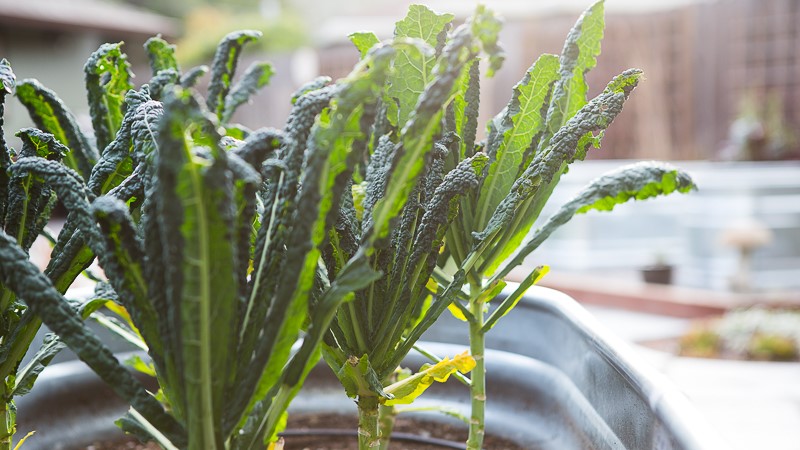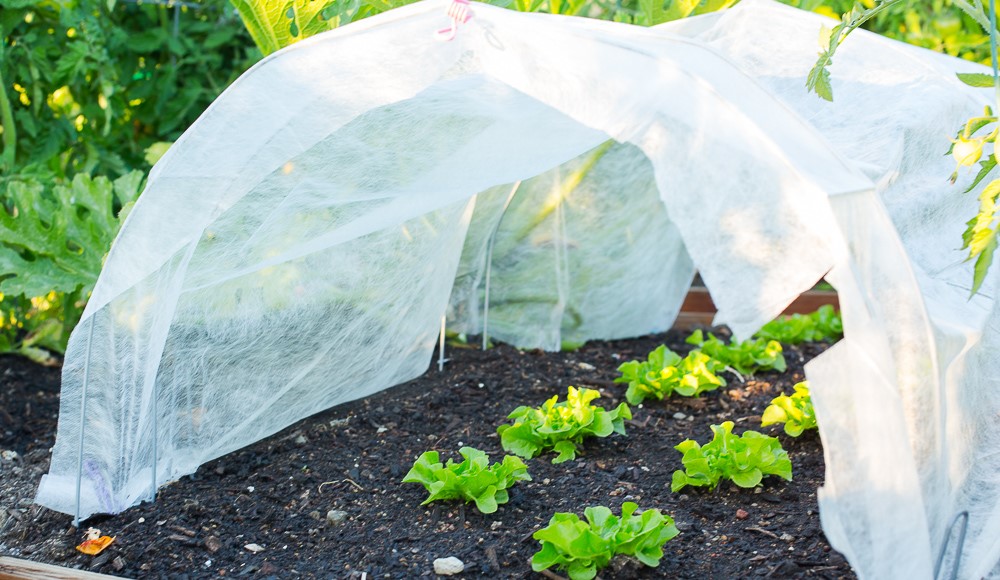By Emily Murphy
With cooler temperatures upon us, it’s time to consider which garden vegetables to grow and how best to protect them. Fortunately, there are easy solutions for protecting winter crops. When choosing your vegetables, look for seed packets and plant tags that reference “cool” or “cold season” in the description. Cool season vegetables are those that thrive and grow when the mercury drops, preferring colder temperatures over warmer weather.
Wondering what winter vegetables to plant this cold season? Keep reading to learn everything you need to know about:
Best Winter Vegetables to Grow
- Carrots – They are perfect winter vegetables because they’re so easy to grow. Just be sure your soil temperature is not cooler than 45°F (you can layer mulch at the base of the plants to keep them warmer). Plant carrots in sun or partial afternoon shade in soil that is well-drained and rich with organic matter. Carrots can survive a light frost, but they should be harvested before the ground freezes. While the root will be ok even after a freeze, the tops will not tolerate it. After harvesting, store carrots in a moist, cool place like your basement.
- Kale – Kale is an exceptional winter vegetable, and some varieties can handle even harsh weather conditions. Kale will germinate in soil as cool at 45°F and can grow in full sun or semi-shade. Begin to harvest in September and continue to do so until the temperature is down to around 20°F. In fact, kale actually tastes better after a first light frost. It won’t last too long after harvesting, so only pull what you will soon use. You will know when kale is ready to be harvested when the leaves are roughly the size or your hand.
- Broccoli – Broccoli thrives in cooler weather and is frost tolerant, making it a wonderful winter garden option. It does require full sun and fertile, rich and moist soil. In general, broccoli can survive temperatures as low as 40°F, and some established plants may even be able to go as low as 25°F. But any lower than that, unless acclimated, may kill the plant. Seeds will germinate at soil temperatures around 40°F. Be sure to harvest before it goes to flower.
- Cabbage – This cool season plant is actually even available in a true late-season variety known as winter cabbage. Winter cabbage needs less water than when growing in summer. It does best when row covers are used if extreme cold and freezes are expected. If growing from seeds, they will germinate in temps as low as 40°F. In some zones, you’ll need to harvest cabbage in early winter. If temperatures are going to plunge, your cabbage may split. For the most part, cabbage can tolerate a moderate frost, but it will likely be damaged by any hard, deep freezes. Once harvested, store heads in a cool cellar or basement for several months. Be sure to remove any damaged leaves before storing.
- Fava Beans – Fava beans, also known as broad beans, is another cool-season crop that is easy to grow in regions where temperatures get as cold as 40°F. They do well in full sun and well-drained, loose soil. They are also frost-tolerant. Water the beans before the soil dries out and take care not to over-water them. You can harvest fava beans in about 85 days and be sure to do so before the pods get tough. Once picked, the beans will keep in the fridge for about a week. You can also freeze, can or dry them.
- Mache – Mache can tolerate extreme cold if it’s well-rooted. It should be planted in full sun in well-drained, fertile soil. Seeds will germinate if the soil is at least 50°F. While it’s relatively slow-growing, these tender greens are easy to grow throughout the winter. Harvest small batches, as needed.
- Arugula – Arugula is a great fall to winter crop, and often can survive moderate freezes and light frosts throughout the cold winter months. You can grow arugula in temperatures as low as 45°F. Be sure to plant in full sun or afternoon shade in soil that is fertile and holds moisture. Harvest young, tender leaves to use as needed. Be sure to use a protective mulch if planting in extreme cold.
- Lettuce – Lettuce does well in cooler temperatures and can generally tolerate a light frost. It will do best when grown anywhere above 45°F. Most varieties, however, need protection from any hard freezes. Plant lettuce in sun or partial afternoon shady areas. Lettuce will grow in several types of soil, but it does need moisture and will do even better with some compost added. Harvest either individual leaves or use a knife to cut plants at the base for a whole-head harvest.
- Kohlrabi – From the cabbage family, kohlrabi likes full sun and well-drained soil that has well-rotted compost added in. It will be ok after a light frost and does great in temperatures as low as 40°F. But extreme cold may be too much for this tender plant. Harvest your kohlrabi once the base of the stems has grown to about the size of a tennis ball. Do not let kohlrabi go too long as it will result in a less-pleasing texture.
- Turnips – Turnips will germinate even when soil temperature is as low as 40°F, making them yet another cool-weather star that will do well in your winter vegetable garden. While hard freezes will damage the flavor of turnips, a light frost can actually improve it! Plant these pretty-colored roots in sun or partial shade and be sure the soil is relatively fertile and well-drained. You can harvest both the leaves of the turnip as well as the root. Your harvested turnips can be stored for several weeks in a cool cellar or dry, dark area.
- Radishes – Radishes are great because they will grow in almost any type of soil as long as there is good drainage. However, these small red beauties are not frost tolerant. They’ll begin to germinate and produce well at a soil temperature around 50°F. They thrive in full sun to partial afternoon shade and should be harvested when they are round and quarter-sized. Young radishes taste the best, so don’t let them go too long.
- Mustard Greens – Mustard greens are a cool-season annual that are known for their ability to germinate in cooler temperatures. They will survive a light frost, but not hard freezes. They need fertile, well-drained soil to really do well. Plant mustard greens in full sun to partial late afternoon shade. Mustard doesn’t generally need to be fed, as it uses up the nitrogen left from summer crops. To harvest, you should use a hoe to chop the leaves at the base – be sure to do this before any hard freezes. Any of the greens not harvested should be turned back into the soil. As an interesting side note, the residue left behind is great to suppress nematodes, which are also known as round worms. This makes mustard a great crop to plant before potatoes.
- Onions – A member of the allium family, onions do best in well-drained, fertile soil mixed with compost. They will perform when planted in soil that’s at least 50°F. You’ll have even better results if onions are planted in raised beds or rows. They are frost tolerant and should be planted in full sun. Onions have two specific harvest times. You can pull young onions as scallions or wait for larger bulbs to form. Once the tops of the plants limp and fall over, you can pull the entire bulb up. For the best results, cure your onions for roughly a week in a warm place before eating or cooking with them.
- Garlic – Garlic bulbs are frost tolerant and flourish in sunny areas. Plant them when the soil temperature is about 50°F at 4 inches deep. They need a fertile, well-drained soil with a fair amount of compost mixed in. They are frost tolerant, but it is best to cover the plantings with at least 3 inches of mulch. Harvest garlic once one-third of the leaves start to dry out and begin to lose the greenish hue they had when young. Dig up the bulbs, shake the soil off and cure the entire plant in a shady, warm spot. Then trim the leaves and store the bulbs. Be careful not to leave them in the ground too long or you will have loose bulbs that will rot quickly after harvest.
- Spinach – Most people are surprised to find out that spinach is a member of the beet family. But it’s true! And these pretty, leafy greens are hardier than they may first appear. In fact, with mulch, spinach can survive harsh winter climates in many areas. Younger plants may begin to bolt in temperatures below 40°F, but the more mature plants can survive in temperatures as low as 25°F. Plant spinach in sun to part shade in rich soil that has been combined with high-nitrogen compost. Keep spinach well-watered and harvest individual leaves as needed. You can also let the plants continue to grow until they resemble rosettes that are leafy and dense. If you notice yellowing leaves or if your spinach seems to be slow-growing, it may be due to nutritional stress. If this is the case, use a water-soluble plant food.

Can Frost Affect Growing Vegetables in Winter?
Frost has the benefit of sweetening winter vegetables and enhancing their flavor. However, even the seeds of winter vegetables need a certain amount of warmth to germinate – check seed packets for details. Most vegetables need protection from extreme cold and wind.
What is the Ideal Soil Temperature for Growing Winter Vegetables?
The vegetables listed above thrive in winter. However, the growth of many, like spinach, lettuces and arugula, slows as temperatures drop. For best seed germination, plant when temperatures are still between 60/65°F and 40°F. This also gives plants time to begin to mature before the coldest days of winter.
When growing vegetables for winter or early spring harvests, it’s important to keep the soil as warm as possible. Some veggies, such as carrots, sweeten when grown in soil that dips below freezing. However, active growth ceases when the soil remains frozen. There are a variety of strategies that will help mitigate freezing temperatures. The colder your region, the more protection you’ll need to offer your winter veggies for optimal results.

How to Protect Winter Vegetables
There are several strategies to protect cool season veggies. The measures you take will depend upon your climate and coldest average winter temperatures (also known as your hardiness zone).
-
- One way to protect veggies is to apply generous layers of mulch and straw to planting beds.
Mulch, like coarse compost and straw, helps protect soil from pelting rains while insulating soil temperatures.
-
- Floating row cover is a specially designed fabric that defends against frost.
It keeps heat in and insulates the soil, protecting plants from cold snaps or sustained low temperatures.
-
- Straw bales continually decompose, and as they do so, they generate heat.
Plant on straw bales or place containers and smaller boxes on straw bales for added warmth.
If you live in the coldest climates, USDA zones 6 to 7, use a combination of tactics to protect your vegetables. Apply mulch with compost and straw in cold frames or hoop houses. If you receive plenty of winter snow, use it as an insulator with mulch and row covers.




